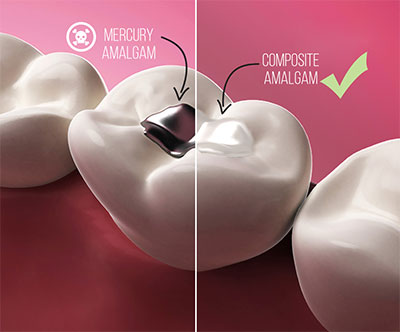HOW DOES METAL CAN IMPACT THE BODY?
Mercury Amalgam Removal
Scientific studies have clearly demonstrated that various metals have cytotoxic, immunological and carcinogenic effects, along with an influence on the person’s metabolism.
There are 3 ways in which metals can impact the body:
- Toxicity (How poisonous it is): Dental amalgams contain mercury, copper, tin, and silver. These form covalent bonds that result in the complete disabling of an enzyme’s ability to function. In addition, when they come in contact with the saliva these corrode, basically they rust and these are swallowed.
- Immunological component: None of the metals used in dental restorations has a function in the human body. Almost every metal is seen as a foreign substance by the body’s immune system, making it liable to trigger an allergy.
- Electrical component: With mobile phones towers, WIFI, radar, and government networks, we are exposed to a wide range of frequencies and forms of electromagnetic radiation. This means that fixed metal restorations and titanium implants in the oral cavity act as small antennas which cause hypersensitive disruptions in the nervous system, plus amplified radiation and warming of the surrounding tissue.

-
Improve your Metabolism
-
Transform your Life
AMALGAM
Even today, amalgam continues to be used routinely in most dental practices worldwide.
After being removed, amalgam must be disposed of as a highly toxic hazardous waste - this fact alone should make us reconsider its use.
Amalgam consists of up to 50% mercury (Hg); which does not remain inert in the filling after being mixed.
From chewing, grinding or brushing one’ teeth, and drinking hot and cold beverages, a certain amount of mercury vapor is released each day.
Mercury is the most toxic, non-radioactive element, even more than lead, cadmium, and arsenic.
As a small dose of mercury vapor is released over an average amalgam lifetime of 20 years, it is thus possible to refer to this as a low-dose chronic poisoning.
DENTAL ALLOYS
Neither gold, nickel, palladium, silver, platinum nor titanium are present biologically in the human body. However, they are routinely used in dental alloys.
These experience a “battery effect”, which produces corrosion of the metal ions and the accumulation of these ions on the body’s own proteins, cell membranes, and enzymes, along with an antenna effect from all of the metals.
One classic example is a gold crown next to an amalgam filling or a gold restoration on a titanium implant, which will cause the “battery effect “ or galvanic element.
Electrogalvanism and the resulting electrical sensitivity are often a cause for loss of concentration and memory, insomnia, unspecific symptoms such as sharp pains or pressure on the chest, palpitations, tinnitus, and loss of hearing, as well as hypersensitive disruptions of the central nervous system.
TITANIUM IMPLANTS AND SCREWS
A non-specific immune response results from a reaction to the titanium particles released due to abrasion when the implant is screwed in. This leads to increased oxidative stress, and titanium oxide particles can be found in regional lymph nodes according to numerous studies.
This means that the lymphatic and immune systems are placed under additional strain.
On the other hand, Zirconium oxide particles from Zirconia implants have not proven to induce the same inflammatory immune response.
Also, like all the other metals, titanium implants also act as small antennas for electromagnetic fields.


